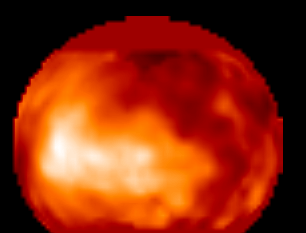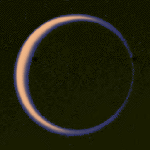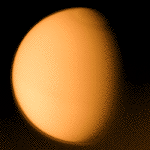
 |
orbit: 1,221,830 km from Saturn
diameter: 5150 km
mass: 1.35e23 kg
In Greek mythology the
Titans
were a family of giants,
the children of Uranus
and Gaia,
who sought to rule the
heavens but were overthrown and supplanted by the family of Zeus.
Discovered by Huygens in 1655.
It was long thought that Titan was the largest satellite in the solar system but recent observations have shown that Titan's atmosphere is so thick that its solid surface is slightly smaller than Ganymede's. Titan is nevertheless larger in diameter than Mercury and larger and more massive than Pluto.
 One of the principal objectives of the
Voyager 1 mission was the study of
Titan. Voyager 1 came within 4000 km of the surface. We learned more in the
few minutes of that encounter than in the previous 300 years.
One of the principal objectives of the
Voyager 1 mission was the study of
Titan. Voyager 1 came within 4000 km of the surface. We learned more in the
few minutes of that encounter than in the previous 300 years.
And yet our knowledge is frustratingly incomplete. Titan is surrounded by a thick, opaque atmosphere; the surface cannot be seen at all in visible light (below left). (The Cassini mission will map Titan's surface with radar as Magellan did at Venus.) All that the Voyager images show is a slight variation in color between the northern and southern hemispheres. Some surface detail is visible in the infrared with HST.
Titan is similar in bulk properties to Ganymede, Callisto, Triton and (probably) Pluto. It is not known whether it has any internal structure like Ganymede or is uniform like Callisto.
Titan is about half water ice and half rocky material. It is probably differentiated into several layers with a 3400 km rocky center surrounded by several layers composed of different crystal forms of ice. Its interior may still be hot. Though similar in composition to Rhea and the rest of Saturn's moons, it is denser because it is so large that its gravity compresses its interior.
Alone of all the satellites in the solar system, Titan has a significant
 atmosphere.
At the surface, its pressure is more than 1.5 bar (50% higher than
Earth's).
It is composed primarily of molecular nitrogen (as is
Earth's) with no more than 6% argon and a
few percent methane. Interestingly, there are also trace amounts of at least
a dozen other organic compounds
(i.e. ethane, hydrogen cyanide, carbon dioxide) and water.
The organics are
formed as methane, which dominates in Titan's upper atmosphere, is destroyed by
sunlight. The result is similar to the smog found over large cities,
but much thicker.
In many ways, this is similar to the conditions on Earth early in its history
when life was first getting started.
atmosphere.
At the surface, its pressure is more than 1.5 bar (50% higher than
Earth's).
It is composed primarily of molecular nitrogen (as is
Earth's) with no more than 6% argon and a
few percent methane. Interestingly, there are also trace amounts of at least
a dozen other organic compounds
(i.e. ethane, hydrogen cyanide, carbon dioxide) and water.
The organics are
formed as methane, which dominates in Titan's upper atmosphere, is destroyed by
sunlight. The result is similar to the smog found over large cities,
but much thicker.
In many ways, this is similar to the conditions on Earth early in its history
when life was first getting started.
Titan has no magnetic field and sometimes orbits outside Saturn's magnetosphere. It is therefore directly exposed to the solar wind. This may ionize and carry away some molecules from the top of the atmosphere.
At the surface, Titan's temperature is about 94 K (-290 F). At this temperature water ice does not sublimate and thus there is little water vapor in the atmosphere. Nevertheless, there appears to be a lot of chemistry going on; the end result seems to be a lot like a very thick smog.
There are probably two layers of clouds at about 200 and 300 km above the surface. Other more complex chemicals in small quantities must be responsible for the orange color as seen from space.
It seems likely that the ethane clouds would produce a rain of liquid ethane onto the surface perhaps producing an "ocean" of ethane (or an ethane/methane mixture) up to 1000 meters deep. Recent ground-based radar observations have cast this into doubt, however.
 Recent observations with the
Hubble Space Telescope
show remarkable near infrared views of Titan's surface
(right and top).
Voyager's camera couldn't see through Titan's atmosphere
but in the near infrared the haze
becomes more transparent, and HST's pictures suggest that a huge bright
"continent" exists on the hemisphere of Titan that faces forward in its
orbit. These Hubble results don't prove that liquid "seas" exist,
however, only that Titan has large bright and dark regions on its surface.
The landing site for the
Huygens probe has been chosen in part
by examining these images. It will be just "offshore" of the largest
"continent" at 18.1 degrees North, 208.7 degrees longitude.
Recent observations with the
Hubble Space Telescope
show remarkable near infrared views of Titan's surface
(right and top).
Voyager's camera couldn't see through Titan's atmosphere
but in the near infrared the haze
becomes more transparent, and HST's pictures suggest that a huge bright
"continent" exists on the hemisphere of Titan that faces forward in its
orbit. These Hubble results don't prove that liquid "seas" exist,
however, only that Titan has large bright and dark regions on its surface.
The landing site for the
Huygens probe has been chosen in part
by examining these images. It will be just "offshore" of the largest
"continent" at 18.1 degrees North, 208.7 degrees longitude.
The observations by HST also indicate that Titan's rotation is in fact synchronous like most of Saturn's other moons.